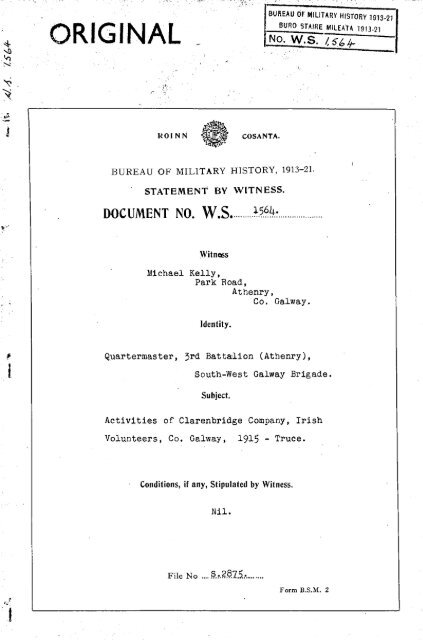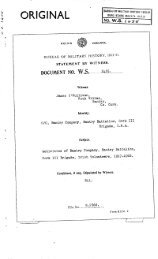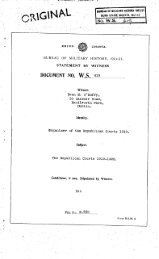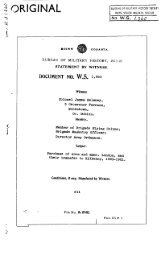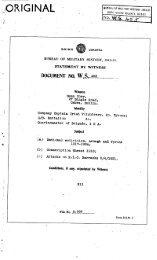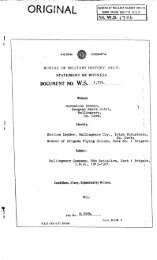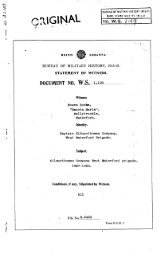RIONN COSANTA. BUREAU OF MILITARY HISTORY, 1913-21 ...
RIONN COSANTA. BUREAU OF MILITARY HISTORY, 1913-21 ...
RIONN COSANTA. BUREAU OF MILITARY HISTORY, 1913-21 ...
Create successful ePaper yourself
Turn your PDF publications into a flip-book with our unique Google optimized e-Paper software.
<strong>RIONN</strong> <strong>COSANTA</strong>.<br />
<strong>BUREAU</strong> <strong>OF</strong> <strong>MILITARY</strong> <strong>HISTORY</strong>, <strong>1913</strong>-<strong>21</strong>.<br />
STATEMENT BY WITNESS.<br />
DOCUMENT NO. W.S.<br />
Witness<br />
1564.<br />
Michael Kelly,<br />
Park Road,<br />
Athenry,<br />
Co. Galway.<br />
Identity.<br />
Quartermaster, 3rd Battalion (Athenry),<br />
South-West Galway Brigade.<br />
Subject.<br />
Activities of Clarenbridge Company, Irish<br />
Volunteers, Co. Galway, 1915 Truce.<br />
Conditions, if any, Stipulated by Witness.<br />
Nil.<br />
File No S.2875.<br />
Form B.S.M.2
STATEMENTBY MICHAEL KELLY,<br />
Park Road, Athenry formerly of<br />
Colwood, Athenry, Co. Galway.<br />
I was born in the year 1892 at Colwood, Athenry. I went<br />
to Colwood National School until I was fourteen years of age.<br />
I joined the Rockfield Company of the Irish Volunteers during<br />
the first half of 1914. The first Captain of the Companywas<br />
Morgan Healy. After a couple of months he was replaced by Gilbert<br />
Morrissey. Afterwards the strength of the Company was about<br />
fifty men. It was organised by Larry Lardner and Stephen Jordan.<br />
Thomas Kenny of Craughwell also was one of the organisers. Parades<br />
were held twice a week. Our training and drill instructor was<br />
Johnny Naughton, a British Army reservist. He was paid at the rate<br />
of 3d. per night for two nights of the week by every man in the<br />
Company. He was a good instructor. We had arms drill a little<br />
later with shotguns.<br />
I joined the I.R.B. in <strong>1913</strong>. As far as I remember I was<br />
sworn in by Archie Heron who was an organiser from the Supreme<br />
Council in Dublin. Pat Callanan, who was Centre of the Circle, was<br />
also present.<br />
In the summer of 1914 Ham Mellows paid a visit to our Company.<br />
He addressed us and we were very impressed by him. Shortly after<br />
I remember he put us through exercises at night time. He divided<br />
us into two groups. The group I was in had the job of attacking<br />
the village of Rockfield. It was through very rough, scrubby<br />
country with numerous stone walls.
I changed from Rockfield Company to Clarenbridge Company<br />
in the early part of 1915, as it was nearer and more convenient.<br />
The Comoany Captain was Eamonn Corbett. Afterwards the strength<br />
was about seventy and parades were held twice a week. The<br />
instructor was an-ex-British soldier whose name I now forget.<br />
I remember we got Instructions to be arming ourselves as best we<br />
could.<br />
Meetings of the I.R.B. were held monthly or oftener if the<br />
matters arose. Pat Callanan presided at the meetings. The<br />
business of the meetings concerned mainly tabulating people who had<br />
arms and where we could lay hands on them if required; keeping a<br />
close eye on the movements of R.I.C. and tabulating those who<br />
showed great friendship for them. The I.R.B. meetings were held<br />
all the time to the Truce, it was also the general policy of the<br />
I.R.B. to fill officerships in the Irish Volunteers by members of<br />
the I.R.B.<br />
There was no change then up to 1916 except that Father Harry<br />
Feeney came as a curate to Clarenbridge about 1915. He was a<br />
native of Two-Mile Ditch, Castlegar, and he did everything he could<br />
to help our Company. He attended nearly all our training parades.<br />
He went whole-heartedly into the organisation of the Company.<br />
He wasn't long ordained at the time and was a very patriotic priest.<br />
Re usually came at some time to our parades at night in the fields.<br />
All important meetings were held in his house.<br />
I remember the big parade of Irish Volunteers held in Athenry<br />
in the autumn of 1914. Volunteers came there from all the<br />
Companies in Galway. Roughly about three thousand men were present<br />
The Review was held in the back lawn where the Kenny Memorial Park<br />
now stands. The lawn was nearly filled. Colonel Moore gave<br />
2.
the words of commandand many local landlords were represented at<br />
the review. This was, of course, before the split. There were<br />
many Volunteers present at the review who resented the presence of<br />
the landlord class. They doubted if these people camefor the good<br />
of Ireland. I was one of those who figured that there was something<br />
wrong. We wondered what was coming or what we were expected to do.<br />
There was no split in either the Clarenbridge or Rockfield Companies,<br />
as these were Shin Féin areas and both Companies were controlled by<br />
the I.R.B.<br />
In the time between the spring of 1915 and 1916 there were<br />
special signalling, scouting and engineering classes formed in each<br />
Company. Instructors came but I cannot remember who they were or<br />
where they came from. We also had lessons in the use of the rifle.<br />
There was a big parade of Volunteers in Galway City on St.<br />
Patrick's Pay 1916. The following Companies, as well as I can<br />
remember, took part:- Clarenbridge, Oranmore, Maree, Athenry,<br />
Ardrahan, Craughwell, Kilconirin, Newcastle, Carnaun, Claregalway,<br />
Castlegar, Spiddal, Kinvara, Ballinderreen, Gort, Killimor, Daly<br />
and Ballycahalan. All marched through Galway City, approximately<br />
about a thousand men all armed with shotguns except for an odd rifle.<br />
There were also two or three members of the R.I.C. from each Company<br />
area and they noted each man who carried a rifle or shotgun. The<br />
object of the march or military parade through Galway was anti-recruiting<br />
for the British Army and perhaps<br />
a rehearsal for Easter<br />
Week. It must have been an order from Headquarters. Galway City<br />
had no Company of Irish Volunteers at the time.<br />
About St. Patrick's Day, 1916, or a little later, Alfe Monaghan<br />
came to Galway. He was 'on the run', and spent his time organising<br />
the Volunteers. He stayed with a family in the parish of<br />
3.
Clarenbridge and visited and instructed the Company on several<br />
occasions. He gave no specialised instruction. He went from<br />
our Company area to Moorepark, Athenry, in the Derrydonnell Company<br />
area.<br />
Our Company, Clarenbridge, got instructions to go to<br />
Confession on Easter Saturday, 1916, and to go to Holy Communion<br />
the following day. The whole Company had breakfast after Mass<br />
at Roveagh Church. The breakfast was prepared and served by Cumann<br />
na mBan in the Church grounds. We brought arms to Mass and the<br />
idea of having breakfast was that there was to be no returning home<br />
after Mass. ( the Saturday night there was a big number of<br />
Volunteers from various Companies in Father Feeney's waiting for<br />
information about the landing of arms. As far as I remember,<br />
Pat Callanan<br />
Martin Niland, Peter Howley, Eamonn Corbett and the "Hare" were present<br />
We remained a good while in the Chapel grounds after Mass on<br />
Easter Sunday and then dispersed. I have an idea that we were told<br />
to remain in readiness although I cannot remember who gave us the<br />
order. It must have been due to the notice in the Sunday<br />
Independent inserted over the name of Eoin McNeill. On Easter<br />
Monday evening at about 7 o'clock I was notified to mobilise at<br />
Killeeneen National School which was unused at the time, and to be<br />
fully armed and equipped. I and the members of the Company from<br />
Colwood went immediately to Kileeneen. Shortly after our arrival<br />
the fun Clarenbridge Company had arrived there. Practically all<br />
the Company were armed with shotguns and about five had rifles,<br />
but I cannot remember the make. About sixty men of the Company<br />
mobilised. Shortly after my arrival at Kileeneen I femember that<br />
I was called to Walshe's house where liam Mellows had his<br />
headquarters. As far as I remember, Eamonn Corbett, Liam Mellows,<br />
4.
Martin Niland, Padraig Fahy and Father Feeney were there. liam<br />
Mellows asked me if I Knew the country around Peterswell and I said<br />
"Yes". He then handed me a dispatch to take to Ballycahalan<br />
Company. Volunteer Patrick Kelly was sent with me and we were armed<br />
with two revolvers and instructed to fight if we contacted the R.I.C.<br />
and if they attempted to interfere with us. I delivered the<br />
dispatch to John Coen of Ballymaquive and he took it to Ballycahalan.<br />
That would be about midnight on Easter Monday night. Kelly and I<br />
waited at Coen's house until John Coen came back from Ballycahalan.<br />
He told me to tell Mellows that the "Ballycahalan Company was<br />
standing to". I then returned to Mellows' Headquarters at<br />
Kileeneen and arrived there at about 8 o'clock on Tuesday morning.<br />
There were no Volunteers there and Kelly and I followed them to<br />
Clarenbridge. When we arrived within a mile of Clarenbridge we saw<br />
members of the Company on sentry duty at the back gate of Lady<br />
Reddington's demesne at Lilcornan. They told us that the R.I.C.<br />
barracks at Clarenbridge was being attacked and we heard the shooting.<br />
We continued to Clarenbridge and I sought out Mellows and gave him<br />
Coen's message that the Ballycahalan Company had mobilised and was<br />
'standing to'.<br />
The attack was still going on when we arrived. The whole<br />
Company was there, all firing at the barracks at a range of about<br />
fifty yards. There was a barricade on the Oranmore Road made of<br />
Mineral water boxes, with Volunteers behind the barricades to<br />
prevent reinforcements from reaching the barracks. All the approache<br />
to the village were barricaded and all traffic held up. About<br />
midday or 1 p.m. the attack was called off. Mellows was in full<br />
charge. No Volunteer was wounded. Then was no R.I.C. man wounded<br />
inside Clarenbridge barracks during the attack.<br />
5.
Just as the attack was about to start an R.I.C. man who<br />
came on a bicycle from Kilcolgan to Clarenbridge got the order<br />
"Hands Up" from two Volunteers on outpost duty, Volunteers<br />
Michael Callanan and Ned Newell. The R.I.C. man did not comply<br />
and he was fired on and badly wounded.<br />
I was at the barricade on the Oranmore Road when Liam Mellows<br />
arrived and ordered the barricade to be taken down. The whole<br />
Company marched to Oranmore, bringing the commandeered horses with<br />
us. On our arrival at Oranmore we heard that the Oranmore and<br />
Maree Companies had attacked the R.I.C. barracks at Oranmore at<br />
about the same time as we had attacked Clarenbridge but that the<br />
attack had failed.<br />
Mellows decided to again attack the barracks with the three<br />
Companies. The local Sergeant had been in his own house when the<br />
first attack occurred. Mellows heard that a force of R.I.C. were<br />
on their way from Galway by train. He called me and Volunteer<br />
Michael Cummins. He sent Cummins to the railway station to find<br />
out if the force of R.I.C. had arrived at the station and what<br />
their strength was. He sent me to the forge near the Sergeant's<br />
house with a section of about six men with instructions not to<br />
allow the Sergeant to leave, his house. The Sergeant made no<br />
attempt to leave his own house. Cummins went to the station on a<br />
bike and the R.I.C. about forty of them had arrived. They<br />
spotted Cummins and fired at him. He escaped and brought word to<br />
Mellows that they were there. Mellows ordered the three Companies<br />
to withdraw and all marched in the direction of Athenry. The<br />
Companies had left the town and Mellows, Cummins and myself and a<br />
few others whom I forget waited until the peeler's marched from the<br />
station. We opened fire on them at a range of from forty to fifty<br />
6.
yards. They took cover at each side of the road in the shelter<br />
of the houses and did not return fire.<br />
We arrived at the farmyard about a mile from Athenry at dark<br />
where Mellows made his Headquarters. Craughwell, Athenry and<br />
Newcastle, Derrydonnell and Cussane Companies arrived at<br />
Headquarters that night. Castlegar and Claregalway Companies<br />
arrived at the farmyard about 11 a.m. on Wednesday morning, having<br />
travelled across country. Their scout, Volunteer Casserly, arrived<br />
Before them having scouted the whole way before them. At this<br />
time I think that there were about 600 or 700 men from the ten<br />
Companies there.<br />
On Wednesday morning early a party of R.I.C. from Athenry were<br />
seen approaching the Headquarters. They were engaged by a party<br />
of Volunteers. The R.I.C. retreated very quickly. They appeared<br />
to be a scouting party of about five to seven men. Eamonn Corbett<br />
was in charge of the party who engaged them and drove them off.<br />
Shortly before midday the Volunteers marched put of the<br />
Farmyard, Company by Company, and proceeded to Moyode Castle by the<br />
Mulpit Road. The Farmyard was not a suitable Headquarters as it<br />
was occupied by students. Moyode was spacious and unoccupied.<br />
The Farmyard was very close to the railway line and there were about<br />
fifty R.I.C. in Athenry and about twenty in Craughwell.<br />
We remained in Moyode Wednesday night, Thursday night and<br />
left it on Friday evening. The different Companies were allotted<br />
quarters for themselves. Sentries were posted in all directions;<br />
all doubled. No skirmish of any kind took place while we were<br />
in Moyode. We had four or five R.I.C. prisoners who had been<br />
taken by the various Companies.<br />
7.
Mellows was in complete control. The other senior officers<br />
were Larry Lardner of Athenry, Martin Niland of Clarenbridge,<br />
Eamonn Corbett of Killeeneen, Sean Broderick of Athenry, Alf Monaghan<br />
of Dublin, Nicholas Kyne of Claregalway and Frank Hynes from Athenry.<br />
The seven hundred men were armed with ten rifles, about five<br />
hundred shotguns, and the remainder were armed with pikes made by<br />
the blacksmiths.<br />
I remember Mellows coming into the room, which with others I<br />
occupied in Moyode,and speaking to a few of us. They asked him<br />
questions as to the situation. As far as I remember he said he<br />
could hold out for a month by moving south to the dare hills.<br />
On Thursday night Alf Monaghan addressed ail the Volunteers and said<br />
that any Volunteer who did not wish to carry on was at liberty to<br />
leave. About one-third left, but some returned the next day.<br />
I remember that Mellows and some officers went out by car on<br />
Thursday night in the direction of Ballinasloe on reconnaissance<br />
as it was rumoured that British Military were advancing on Moyode.<br />
The rumours about the British advance and the uncertainty, along<br />
with the withdrawal of the two hundred men, had a disturbing effect<br />
on ail the Volunteers at Moyode on the Thursday night. We got no<br />
sleep that night as we were called out a few times during the<br />
night and lined in our Companies for roil call. I was on sentry<br />
duty about five hundred yards south of the castle with two other<br />
Volunteers, John Grealish and TommyBendon both from Clarenbridge<br />
Company.. We came back to Headquarters about 8 o'clock after<br />
having done duty for about seven hours. There would have been<br />
forty sentries out in the woods surrounding the castle. Rations<br />
were brought<br />
out to us.<br />
8.
Friday morning: As far as I remember on Friday about noon<br />
I was ordered by Liam Mellows to go to Fahy's of Templemartin and<br />
to bring two cyclists, who were staying at Fahy's, to Headquarters.<br />
They were holiday makers on their way from Athlone to Galway.<br />
We brought them in and he questioned them as to whether they had<br />
seen any British Military in any part of their travels. They<br />
said they didn't and they were let go.<br />
About 6 p.m. all the Companies got word to line up, to tackle<br />
the horses and get all baggage ready. We had a lot of potatoes<br />
and provisions of all kinds We marched out of Moyode by<br />
Companies. I think it was Martin Niland who was in charge of our<br />
Company. As we were leaving Moyode I remember that Liam Mellows<br />
called me and Volunteer Michael Cummins who was from my own place<br />
Colwood. Mellows told Cummins to scout the roads in advance with<br />
other scouts. He told inc to take a section of eight to ten men to<br />
act as rearguard. I did not know then where our destination was.<br />
We went through bye roads by the east of Craughwell by Ballymana<br />
Church through Monksfield. When we arrived at Monksfield it was<br />
nightfall and dusk, and I saw two men dressed in black on bicycles<br />
following us. I ordered my section to take cover and I called on<br />
the two cyclists to halt. They were coming with such speed that<br />
they ran right into our position before they could stop. We found<br />
that they were two priests who wanted to see Mellows. I was<br />
suspicious and I questioned them closely. They gave their names<br />
and I think they passed some remark about the surrender of the<br />
Volunteers in Dublin. I brought them to Mellows when we were<br />
within a half a mile of Limepark.<br />
When Mellows and the two priests and other officers reached<br />
Limepark they went into a room where they had a meeting. I<br />
happened to be sitting on the window sill of the room in which the<br />
9.
meeting was held. I beard one of the priests telling all the<br />
officers assembled about the surrender in Dublin. A discussion<br />
then arose mainly between the priest and Mellows. The priest<br />
was trying to convince the meeting that, as the Volunteers in Dublin<br />
had surrendered, the Galway Volunteers should disperse as the<br />
position was hopeless in the circumstances. The priests asked<br />
Mellows whether he would be agreeable to put it to the men whether<br />
they would disperse or carry on. Mellows said that he had already<br />
put it up to the men in Moyode and that every man in Limepark had<br />
agreed to carry on. The priest said that as Dublin had been<br />
dispersed, the British Forces could concentrate fully on Galway.<br />
Mellows still refused to go to the men for a decision as he<br />
maintained it had been already taken. The priests asked him then<br />
if he would allow them to put it to the men and after some<br />
hesitation he agreed. One of the priests then addressed the<br />
Volunteers who were assembled on the lawn. He said the Volunteers<br />
had surrendered in Dublin and that he had come to ask us to<br />
disperse. He said Galway had done well and that as Dublin had<br />
surrendered there was no point in carrying on and he asked us to<br />
disperse and return to our homes quietly. We then dispersed.<br />
I was arrested on the 3rd May in my own home. I was brought<br />
to Moyvilla R.I.C. barracks and kept a day there and then brought to<br />
Galway Jail. I spent about ten days in Galway Jail, which was<br />
overcrowded. With about three hundred other prisoners I was<br />
brought by train to Dublin. On our way from Galway Jail to the<br />
Station on foot under a heavy escort we were boohed and jeered at<br />
by the people of Galway. We were brought to Richmond barracks in<br />
Dublin. We were marched from Broadstone Station and brought<br />
through the back streets, and were made to double through some of<br />
them. We got a good reception from the Dublin people. On arrival<br />
10.
in Richmond Barracks we were accommodated in barrack rooms<br />
twenty-four in each room.<br />
After three or four days we were marched at night to the<br />
North Wall and put on a cattle boat.<br />
We were a gay party singing and dancing. Some more serious-minde<br />
of the prisoners were of the opinion that the British were<br />
taking us out to sea to sink us, and others said we were put on<br />
the cattle boat so that the Germans, if they sank the boat, would<br />
take it for what it was and would not make any attempt to rescue<br />
us. We were brought to Glasgow and separated into two batches.<br />
My batch marched through Glasgow to whatever station was the<br />
terminus for Perth. We got a good reception in Glasgow. There<br />
were about two hundred in our batch including some Wexford men.<br />
We were lodged in Perth Jail. We got a bad reception at Perth<br />
railway station; the people thought we were deserters from the<br />
British army and boohed us. We returned the boohs with vengeance.<br />
After about two months we were shifted to Frongoch Camp in<br />
North Wales. Later we were brought before the Advisory Commission<br />
in London. We spent two nights in WormwoodScrubbs. The members<br />
of the Advisory Committee were very pleasant fellows. They knew<br />
every move I made for the twelve months previous to the Rising.<br />
They knew an about the dances I attended, the girls I was friendly<br />
with, and that I carried a gun in Galway on the St. Patrick's Day<br />
Parade 1916. They asked ne did I know what I was going to do<br />
when I was called out in Easter Week. I answered that I did, and<br />
that I was looking for the freedom of n country as any decent man<br />
would do in an unfree country. I was released about the end of<br />
August, 1916.<br />
11.
The Irish Volunteers were reorganised in 1917 and I rejoined<br />
the Clarenbridge Company and remained with that Company until I was<br />
appointed Battalion Quartermaster of the 3rd Battalion (Athenry)<br />
South West Galway Brigade early in 19<strong>21</strong>. The other officers of the<br />
Battalion were O/C. Gilbert Morrissey, Vice 0/C. my brother William<br />
Kelly, Adjutant Stephen Jordan. When Jordan was arrested he was<br />
replaced by John O'Dea, The Wier, Clarenbridge. Jim Barrett was<br />
Quartermaster until he was arrested and I succeeded him.<br />
I took part in the general. election work in l9l8 and in the<br />
collection of the Dáil Éireann Loan. I acted as outpost in<br />
connection with the Bookeen Barrack attack. Although my duties were<br />
mainly of a routine nature I took part in some prepared ambushes,<br />
raids on mails, burning of evacuated barracks etc.<br />
I was a marked man by the R.I.C. during the whole of the War of<br />
Independence and my brother William was the same. We were not able<br />
to remain in our awn home for most of the time and suffered a good<br />
deal of hardship and loss. We always slept out from about the middle<br />
of 1920 to the Truce in camps in out-of-the-way places.<br />
SIGNED: Michael<br />
DATE: 22rd<br />
WITNESS: Seán Brennan Lieut. Col<br />
Jan<br />
Kelly<br />
1957<br />
12.


